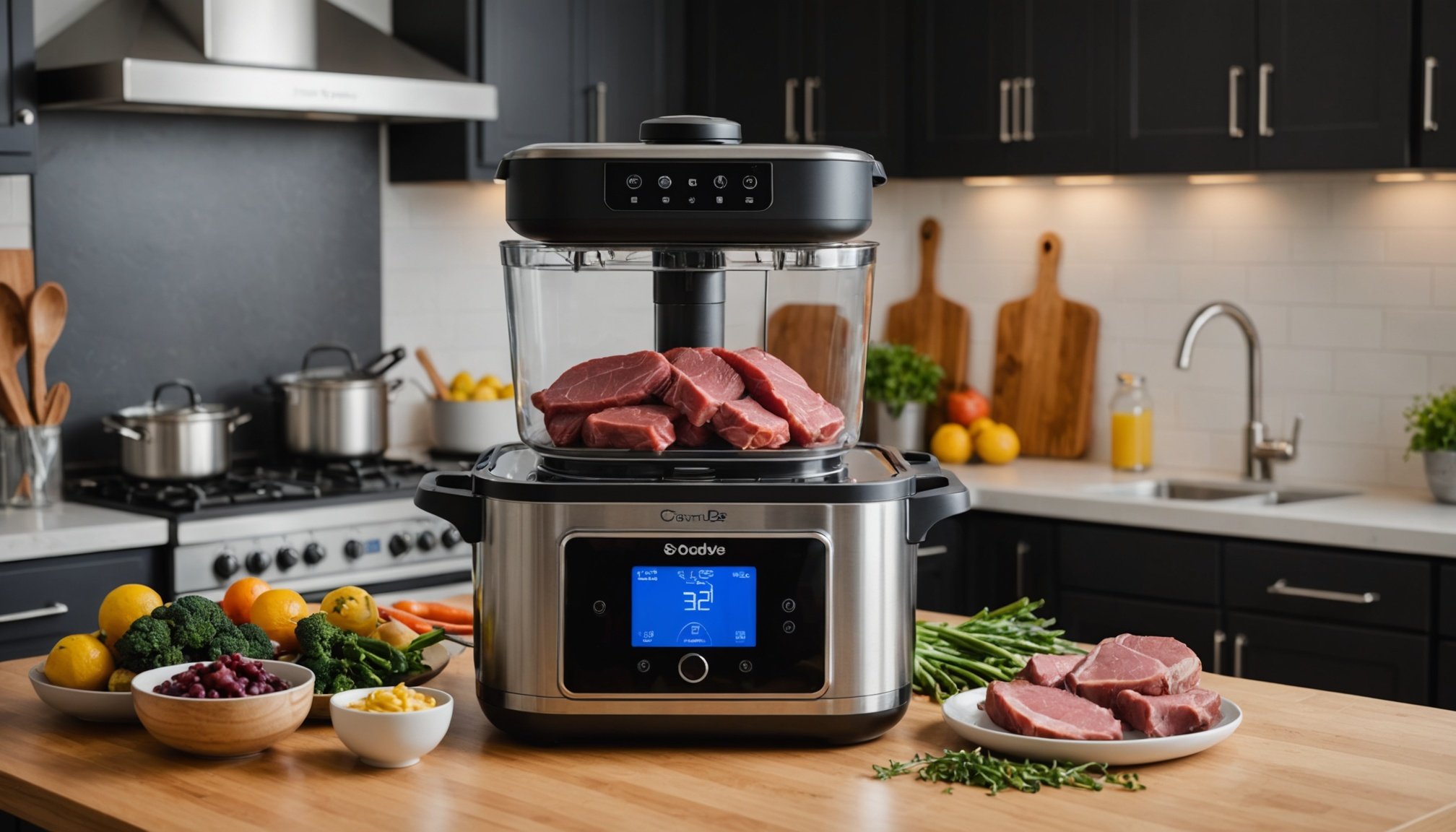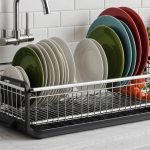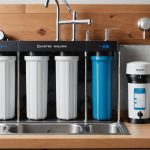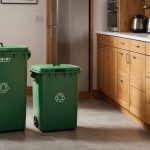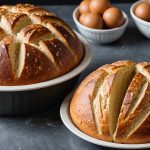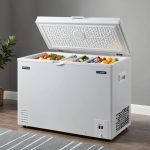Understanding Sous-Vide Cooking
Sous-vide cooking has become a staple in modern culinary techniques, distinguished by its precision and consistency. Originating from France, sous-vide, meaning “under vacuum” in English, involves vacuum-sealing food in a bag and cooking it to a very precise temperature in a water bath. This culinary innovation has been embraced globally for its ability to enhance food preparation.
One of the primary benefits of sous-vide cooking is the unmatched flavour concentration and texture improvement it offers. By cooking food evenly and preserving its natural moisture and juices, the technique ensures that dishes are tender and bursting with taste. For precision cooks, this method transforms even the toughest cuts of meat into tender, juicy bites.
Topic to read : Ingenious Ideas for Seamlessly Hiding Your Kitchen Appliances
However, several common misconceptions surround sous-vide methods, often deterring enthusiastic home cooks. Some believe sous-vide cooking is time-consuming or requires expensive equipment. In reality, while the cooking process may take longer than traditional methods, the hands-on preparation time is typically shorter, and entry-level sous-vide devices are now more affordable. Furthermore, concerns about safety and the risk of bacteria are often unfounded, as maintaining a consistent temperature during sous-vide cooking effectively destroys harmful pathogens. This delightful mix of safety, simplicity, and sophistication makes sous-vide a valuable technique for both novice and seasoned chefs.
Choosing Your Sous-Vide Equipment
Selecting the right sous-vide equipment can significantly enhance your culinary experience. A sous-vide machine, also known as an immersion circulator, is critical for achieving precise temperature control when cooking.
Also read : Brilliant kitchen lighting: expert tips to reduce glare on surfaces for a perfect ambiance
Essential Features to Consider
When choosing a sous-vide machine, key features should include temperature accuracy, water circulation, and ease of use. A high-quality immersion circulator will maintain a consistent water temperature, which is crucial for achieving perfectly cooked dishes. Look for machines with digital interfaces and intuitive controls to simplify the cooking process. It’s also beneficial if the device offers connectivity features such as Bluetooth or Wi-Fi, allowing you to monitor and adjust settings remotely.
Top Recommended Sous-Vide Machines
Some of the top sous-vide machines available today are known for their reliability and advanced features. The Anova Precision Cooker and the Breville Joule stand out due to their excellent performance and connectivity options. Both machines offer precise temperature control, a user-friendly interface, and robust app support, making them favorites among culinary enthusiasts and professionals alike.
Budget-Friendly Versus High-End Options
For those just starting with sous-vide cooking, budget-friendly options like the Instant Pot Accu Slim offer many essential features at a more accessible price point. In contrast, high-end options provide greater precision, power, and additional features, appealing to experienced chefs.
Setting Up Your Sous-Vide System
Setting up a sous-vide system can seem daunting, but a simple step-by-step approach makes it manageable. First, fill your sous-vide bath with water, ensuring the water level aligns with device specifications for optimal performance. Attach your temperature control device securely to the side, allowing it to monitor and maintain precision.
Water temperature and circulation are crucial in sous-vide cooking. They ensure even cooking, locking in flavour and nutrients. Set the desired temperature on your device, keying into the specific cooking methods suited for your dish, like meats or vegetables. A well-circulated bath prevents cold spots and uneven heating.
Food safety, while cooking sous-vide, is paramount. Always start with fresh ingredients, properly vacuum-sealed to prevent bacteria growth. Vacuum sealing offers extended storage, preserving taste and texture. Ensure there are no air pockets in the bags, as they can hinder the cooking process and potentially cause food not to heat through properly.
Tips for Success:
- Monitor the sous-vide bath periodically to ensure stable operation.
- Avoid stacking bags to promote water circulation around each item.
- Use vacuum-sealed bags specifically designed for sous-vide to guarantee airtight seals and high-temperature resistance.
This straightforward sous-vide setup guide channels the benefits of this innovative cooking style, ensuring high-quality results and superior taste.
Essential Sous-Vide Techniques
Sous-vide cooking has revolutionized kitchen practices, allowing culinary enthusiasts to achieve precision and consistency. Let’s delve into mastering various sous-vide techniques and enhancing your culinary skills.
Mastering Temperature Control
Understanding and controlling temperature is crucial in sous-vide cooking methods. The water bath serves as the core element to maintain low, precise temperatures. For instance, maintaining 54°C (129°F) for proteins like steak ensures even cooking without overcooking. Reliable immersion circulators help achieve and uphold these temperatures, creating a perfect environment. Each ingredient requires specific temperature settings to optimize texture and flavour, which necessitates culinary skills in balancing these variables.
Cooking Times for Different Ingredients
Cooking time differs per ingredient, and knowing this is essential for sous-vide techniques. Meat like chicken may need two hours at a set temperature for full tenderness, while vegetables like carrots cook perfectly at higher degrees for a shorter duration. Eggs often require just one hour to reach ideal consistency. With accurate timing, the method maximizes flavour retention without nutrient loss.
Achieving Perfect Doneness
Sous-vide ensures meats achieve desired doneness and texture with minimal fuss. This technique allows precision unattainable with conventional cooking methods. Vacuums seal foods, immersing them in a controlled water bath. To determine doneness, use touch or visual cues post-cook. This culinary skill makes it simple to perfect steaks or tenderize tough meat cuts.
Delicious Sous-Vide Recipes
The art of sous-vide cooking has captivated both novice and expert chefs alike, offering a unique culinary approach that guarantees precision and flavour. For beginners looking to dive into this world, several easy sous-vide recipes provide a fantastic starting point. Consider the classic sous-vide egg, a foolproof recipe offering creamy textures unattainable through traditional methods. Similarly simple is the sous-vide chicken breast. Just season, seal, and sous-vide for succulent results every time.
For those already familiar with sous-vide, delving into intermediate and advanced recipes can enhance your culinary repertoire. Try sous-vide beef tenderloin, which promises melt-in-your-mouth tenderness, or a more complex task like sous-vide duck breast with a reduction sauce. Such dishes can highlight your skill and adaptability within the kitchen.
Creativity shines in meal ideas using sous-vide as the central technique. How about sous-vide salads where proteins like salmon or chicken are the star players, perfectly cooked to complement fresh greens and zesty dressings? Or sous-vide-infused cocktails, where precise temperature control develops flavors in spirits.
Through each level of expertise, sous-vide cooking offers endless cooking inspiration, pushing culinary boundaries and ensuring exceptional dining experiences.
Common Mistakes to Avoid
Understanding the nuances of sous-vide cooking can prevent common mistakes and elevate your culinary creations. Here, we unpack frequent cooking errors and offer practical kitchen tips to refine your technique.
Overcooking and Undercooking
Timing is crucial in sous-vide cooking. A frequent mistake is either overcooking or undercooking due to not adjusting the cooking time for the thickness of the meat or ingredients. Sous-vide provides precise temperature control, yet not calculating the time according to your ingredient’s size can detract from its texture and doneness. Monitoring with a reliable thermometer can mitigate this error, ensuring perfect results.
Importance of Vacuum Sealing
Vacuum sealing is vital for effective sous-vide cooking, serving as a barrier against water and preserving flavours. Inadequate sealing can result in water seeping into the bag, causing uneven cooking. Ensure your vacuum sealer fully extracts air from the bag before sealing. This step is foundational to a successful sous-vide process, delivering optimal mouthfeel and juiciness.
Neglecting Flavoring and Seasoning
While sous-vide cooking can enhance natural flavours, proper seasoning is key. A typical sous-vide mistake involves insufficient seasoning which can lead to bland outcomes. Prior to vacuum-sealing, generously season or add aromatics to your ingredients to fully leverage the sous-vide process. This practice infuses your dish with rich, consistent flavours.
Enhancing Your Sous-Vide Experience
Unlock the full potential of your sous-vide cooking by integrating it with other techniques like searing. After achieving the perfect doneness through sous-vide, a quick sear on high heat can create a crisp, caramelised crust without overcooking. This technique enhances both the flavour and texture, elevating your dish from good to gourmet.
Ever considered how flavor infusion can transform your sous-vide endeavours? Utilising the controlled temperature environment, marinating becomes more effective. The gentle cooking process allows marinades to penetrate deeply, resulting in richer, more intense flavours. Choose marinades that complement the natural taste of the meat or vegetables to enhance the culinary experience.
An array of tools and accessories are available to magnify the versatility of sous-vide cooking. Vacuum sealers ensure optimal air removal for better temperature control, while immersion circulators maintain even water temperature. Specialised containers can prevent heat loss, ensuring efficient cooking times. Each tool contributes to precision, consistent results, and overall culinary improvement.
In summary, combining sous-vide with complementary cooking techniques and embracing tools like marinades and specific equipment can significantly enhance your cooking prowess. This multifaceted approach not only elevates flavour but also bridges the gap between amateur cooking and professional culinary excellence.
Visual Aids and Expert Insights
Engaging in the world of sous-vide cooking can be greatly enhanced through visual aids and expert insights. These resources cater to different learning preferences, ensuring that everyone finds the cooking guides they need.
Recommended Videos and Tutorials
Platforms like YouTube offer a wealth of sous-vide content. These video resources cover everything from basic techniques to advanced culinary skills. Look for channels hosted by professional chefs, as they’re more likely to provide reliable and high-quality sous-vide visuals. This can make it easier to understand the process and replicate it at home.
Expert Tips from Culinary Professionals
Learning from culinary experts can transform your sous-vide cooking. Chefs often share insights into flavour combinations and precise cooking times, enhancing your dishes. Expert advice can also guide you in choosing the right equipment and troubleshooting common problems, allowing you to cook with confidence and culinary expertise.
Community Resources and Forums
For a more interactive experience, explore online communities dedicated to sous-vide cooking. These forums offer a platform to share recipes, ask questions, and gain knowledge from fellow enthusiasts. You’ll find plenty of inspiration and practical advice, ensuring that you can continually improve your sous-vide skills.

